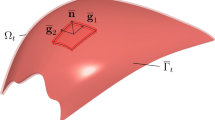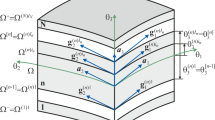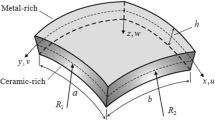Conclusion
In [8, 9] and in the present paper we analyzed the possibilities of using the approximate approach [15, 18] in the three-dimensional stability theory of deformable bodies as applied to effects of internal and surface instability and to stability of thinwalled structural elements. The analysis mentioned has been performed by comparing for standard problems the results obtained by the approximate approach [15, 18] with the results for the similar problems, obtained within the three-dimensional linearized stability theory of deformable bodies (for example [2–5, 7, 10, 19]), constructed with the accuracy usually adopted in mechanics. The following conclusions are drawn as a result of the analysis.
Applied to effects of internal and surface instability, the approximate approach leads to result in disagreement with the corresponding results of the three-dimensional linearized stability theory of deformable bodies.
As applied to the study of stability of thin-walled structural elements, the use of the approximate approach is justified if we restrict ourselves to a calculational accuracy of critical loads corresponding to that of the Kirchhoff-Love hypothesis.
In connection with the discussion above, numerous publications carried out on the basis of the approximate approach require further study to clarify the validity limits of the results obtained.
Similar content being viewed by others
Literature Cited
A. N. Guz', “Accuracy of the Kirchhoff-Love hypothesis for determination of critical forces in the theory of elastic stability,” Dokl. Akad. Nauk SSSR,179, No. 3, 552–554 (1968).
A. N. Guz', Stability of Three-Dimensional Deformable Bodies [in Russian], Naukova Dumka, Kiev (1971).
A. N. Guz', Stability of Elastic Bodies for Finite Deformations [in Russian], Naukova Dumka, Kiev (1973).
A. N. Guz', Foundations of Stability Theory of Mines [in Russian], Naukova Dumka, Kiev (1977).
A. N. Guz', Stability of Elastic Bodies under Hydrostatic Stress [in Russian], Naukova Dumka, Kiev (1979).
A. N. Guz', “Analysis of computational schemes in stability theory of structural elements of composite materials,” Dokl. Akad. Nauk UkrSSR, Ser. A, No. 4, 31–36 (1980).
A. N. Guz', Mechanics of Brittle Destruction of Materials with Initial Stress [in Russian], Naukova Dumka, Kiev (1983).
A. N. Guz', “Three-dimensional stability theory of deformable bodies. Internal instability,” Prikl. Mekh.,21, No. 11, 3–17 (1985).
A. N. Guz', “Three-dimensional stability theory of deformable bodies. Internal instability,” Prikl. Mekh.,22, No. 1, 3–18 (1986).
A. N. Guz' and I. Yu. Babich, Three-Dimensional Theory of Bars, Plates, and Shells [in Russian], Vishcha Shkola, Kiev (1981).
A. N. Guz' and A. N. Sporykhin, “Three-dimensional theory of inelastic stability,” Prikl. Mekh.,19, No. 7, 3–22; No. 8, 3–27 (1982).
A. N. Guz' and V. N. Chekhov, “Linearized theory of fold formation in the thick core of the earth,” Prikl. Mekh.,11, No. 1, 3–14 (1975).
Zh. S. Erzhanov and A. K. Egorov, Theory of the Fold Formation Process in Rocks (Mathematical Description) [in Russian], Nauka, Alma-Ata (1968).
L. V. Ershov and D. D. Ivlev, “Bulge of a thick-walled tube under the action of internal pressure,” Izv. Akad. Nauk SSSR, Otd. Tekh. Nauk, No. 8, 149–152 (1957).
A. Yu. Ishlinskii, “Treatment of stability problems of equilibrium elastic bodies from the point of view of mathematical elasticity theory,” Ukr. Mat. Zh.,6, No. 2, 140–146 (1954).
I. D. Legenya, “Stability of a thick rectangular simply supported slab under the action of compressing loads,” Dokl. Akad. Nauk SSSR,140, No. 4, 776–779 (1961).
I. D. Legenya, “Stability of a compressed plate with account of rotational angles,” Dokl. Akad. Nauk SSSR,149, No. 4, 802–805 (1963).
L. S. Leibenzon, Application of Harmonic Functions to the Stability Problem of Spherical and Cylindrical Shells (Collected Works, Vol. 1) [in Russian], Izd. Akad. Nauk SSSR, Moscow (1951).
V. V. Novozhilov, Foundations of Nonlinear Elasticity Theory [in Russian], Gostekhizdat, Moscow (1948).
Zh. S. Erzhanov, A. K. Egoroy, I. A. Garagash, et al., Theory of Fold Formation in the Earth's Core [in Russian], Nauka, Moscow (1975).
J. L. Nowinski, “On the elastic stabiity of thick columns,” Acta Mech., No. 7/4 (1969).
Additional information
Institute of Mechanics, Academy of Sciences of the Ukrainian SSR, Kiev. Translated from Prikladnaya Mekhanika, Vol. 22, No. 2, pp. 3–17, February, 1986.
Rights and permissions
About this article
Cite this article
Guz', A.N. Three-dimensional stability theory of deformable bodies. Stability of construction elements. Soviet Applied Mechanics 22, 97–108 (1986). https://doi.org/10.1007/BF00886996
Received:
Issue Date:
DOI: https://doi.org/10.1007/BF00886996




